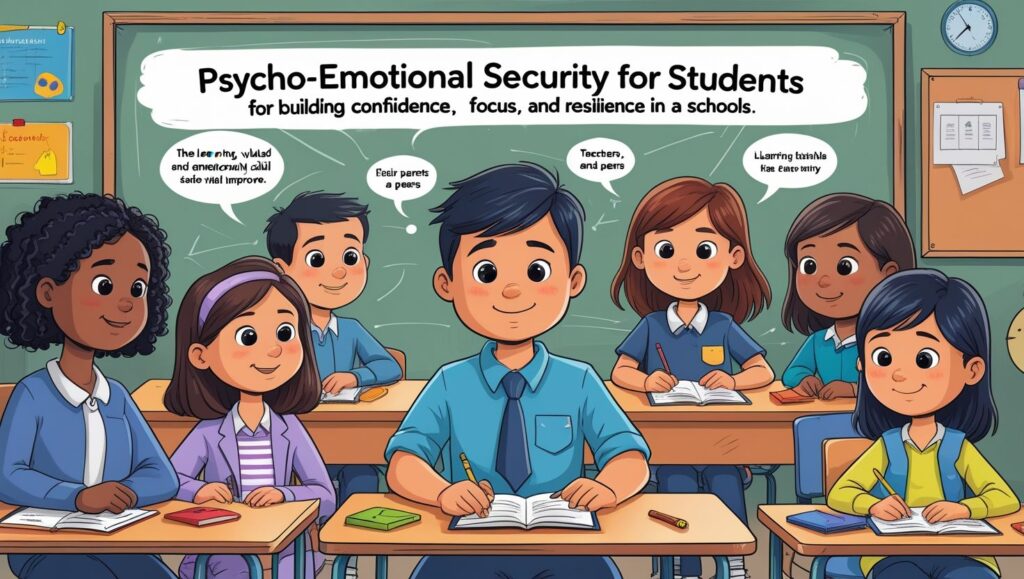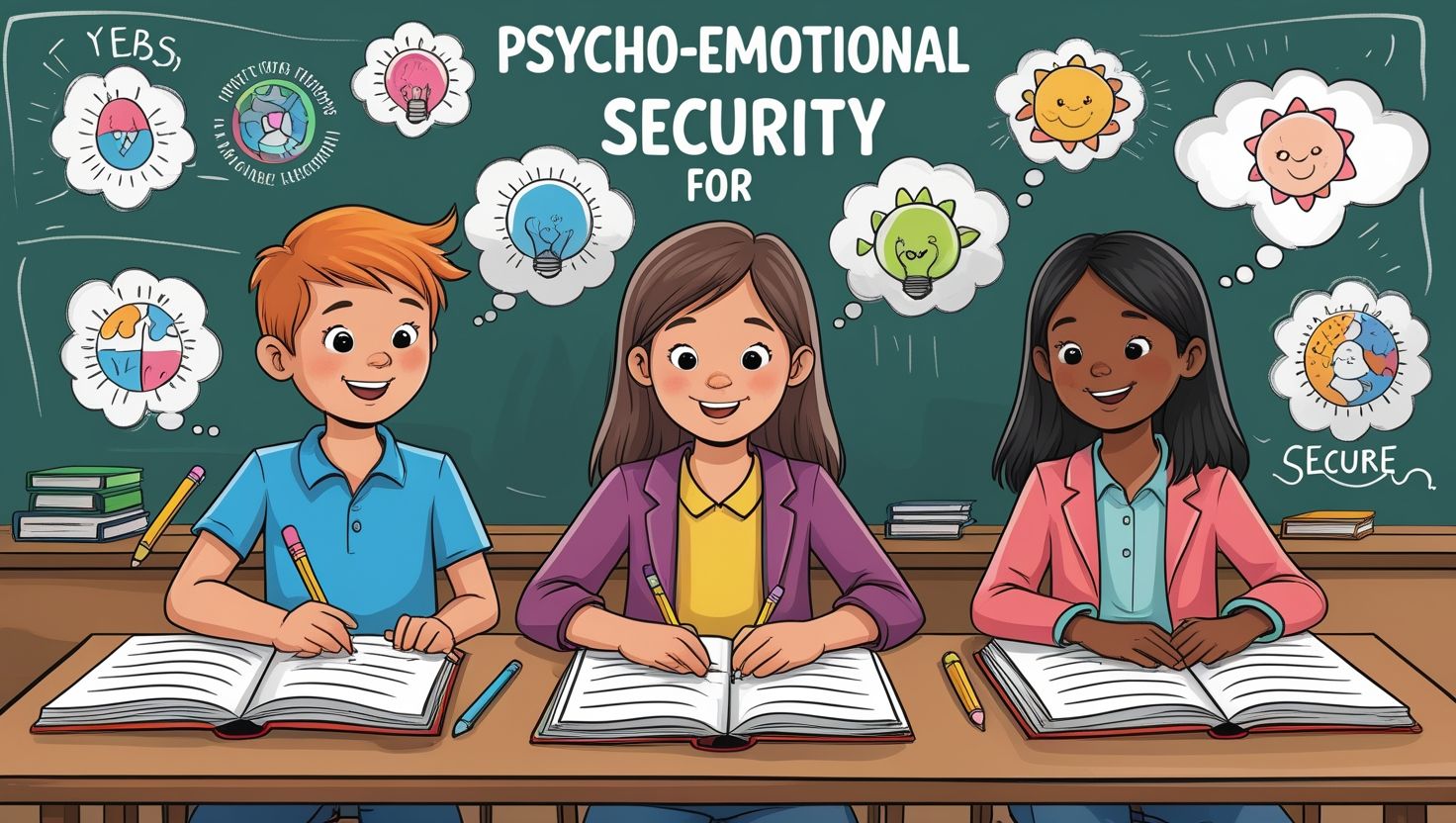Introduction
Psycho-Emotional Security for Students, Schools are not just places of academic learning. They also provide the emotional and psychological environment that shapes children’s overall development. When students feel secure, they can focus better, form positive relationships, and achieve higher levels of success. Creating psycho-emotional security means offering children safety from bullying, stress, and anxiety, while also nurturing their self-esteem and confidence. Teachers, parents, and administrators all share responsibility for fostering this supportive space.
Moreover, The Critical Role of Early Childhood Development cannot be ignored, as it lays the foundation for a child’s emotional well-being later in life. Without early guidance, students may struggle with mental health challenges that affect learning. Therefore, schools must design environments where safety, empathy, and belonging are prioritized. This not only reduces stress but also allows children to thrive academically and socially. A secure environment transforms schools into communities of growth and support.
Understanding Psycho-Emotional Security in Schools
Psycho-emotional security refers to the sense of safety students feel in their learning environment. It is not limited to physical safety; it also includes freedom from emotional harm, fear, or constant stress. When students are emotionally secure, they participate more actively in class and build meaningful relationships with teachers and peers. In contrast, insecurity can lead to absenteeism, poor performance, and even behavioral issues. Schools must therefore recognize the importance of emotional well-being alongside academic excellence.
The Critical Role of Early Childhood Development is evident here, as children who develop emotional regulation skills early adapt better in classrooms. Secure environments ensure that students can express themselves without fear of judgment. Teachers who promote open communication and inclusivity help reduce anxiety levels. Establishing respect, fairness, and empathy as core classroom values ensures that every student feels valued. Thus, psycho-emotional security is the backbone of a productive learning community.

The Impact of Emotional Security on Learning
Emotional well-being has a direct impact on how students learn. When learners feel stressed, anxious, or unsafe, their ability to concentrate decreases. Their memory retention and problem-solving skills are also negatively affected. On the other hand, students who feel emotionally secure display greater motivation, creativity, and resilience. Schools must recognize that emotional health is as crucial as physical health for academic progress.
Additionally, The Critical Role of Early Childhood Development demonstrates that children with strong emotional foundations are more adaptable and confident in later schooling. Emotional security fosters curiosity and reduces the fear of failure, encouraging students to take intellectual risks. Teachers play an important role by validating students’ emotions, offering encouragement, and ensuring inclusive participation. By integrating psycho-emotional support into daily routines, schools create conditions where children can flourish. Ultimately, learning outcomes are enhanced when the emotional climate of the classroom is positive and stable.
Teachers as Key Facilitators of Security
Teachers play a central role in promoting psycho-emotional security within schools. Their interactions with students influence how safe and supported learners feel. A teacher who listens actively, responds empathetically, and creates fair rules builds trust. Students are more likely to engage when they feel their voices matter. Importantly, The Critical Role of Early Childhood Development shows that the presence of nurturing adults in early years greatly impacts future confidence and resilience. Teachers must use strategies such as positive reinforcement, conflict resolution, and collaborative learning to foster security. Classroom practices should encourage inclusivity while discouraging discrimination or favoritism.
When educators model respectful behavior, students follow their example. Furthermore, professional training in emotional intelligence can help teachers recognize signs of distress and provide timely support. In essence, teachers act not only as knowledge providers but also as emotional anchors, guiding students toward secure and meaningful learning experiences.
Role of Parents in Emotional Security
Parents significantly influence children’s emotional well-being within school settings. Their involvement ensures continuity between home and school, reinforcing positive emotional development. Supportive parenting styles that include listening, empathy, and encouragement help children face academic and social challenges confidently. Moreover, The Critical Role of Early Childhood Development highlights the importance of family nurturing during formative years.
When children experience stability and love at home, they are more likely to feel secure in school. Parents must maintain open communication with teachers to address issues like bullying or academic stress promptly. Participation in school activities also shows children that education is a shared priority. Consistency in rules and expectations between home and school creates a balanced structure for students. Ultimately, when parents collaborate with schools, students experience holistic emotional support. Therefore, families and schools must work hand-in-hand to establish a foundation of psycho-emotional security for every learner.

School Policies Supporting Emotional Well-Being
Institutional policies shape how well schools address psycho-emotional needs. Effective policies ensure that students’ mental health is prioritized alongside academics. For example, anti-bullying laws, counseling services, and peer-support programs all enhance emotional security. Schools must adopt comprehensive frameworks that protect students from harassment while promoting inclusivity. Importantly, The Critical Role of Early Childhood Development underlines the need for early policy intervention to prevent long-term harm. Schools that integrate social-emotional learning programs into curricula see noticeable improvements in student behavior and academic achievement.
Moreover, policies should encourage teacher training in mental health awareness. Regular workshops, feedback systems, and crisis management protocols further enhance safety. Transparent communication with parents and students builds trust in the institution. By embedding emotional security into formal guidelines, schools create a consistent and reliable system of support. Such proactive measures ensure that students not only learn but also thrive in safe environments.
Peer Relationships and Emotional Safety
Peer relationships strongly influence psycho-emotional security in schools. Friendships offer support, belonging, and comfort, while negative peer interactions can lead to bullying and exclusion. Encouraging positive peer engagement reduces stress and fosters cooperation among students. Group activities, peer mentoring, and cooperative projects can strengthen trust and empathy. Furthermore, The Critical Role of Early Childhood Development highlights that children who learn social skills early form healthier peer connections later.
Schools should provide structured opportunities for collaboration where respect and inclusivity are central. Teachers must monitor interactions to prevent conflicts from escalating into emotional harm. Promoting kindness campaigns and student councils can give children a voice in shaping their environment. Peer support also teaches problem-solving and conflict resolution, valuable skills beyond the classroom. Ultimately, strong peer relationships contribute significantly to emotional safety. A culture of acceptance and mutual respect makes schools more welcoming and supportive spaces for all learners.
Challenges to Psycho-Emotional Security in Schools
Despite efforts, many schools still face challenges in ensuring emotional safety. Bullying, academic pressure, discrimination, and lack of resources remain common barriers. Some students also struggle with external factors such as family conflict or socioeconomic stress, which affect their school behavior. Teachers may feel unprepared to handle complex emotional issues, and inadequate counseling services often worsen the problem. However, The Critical Role of Early Childhood Development reveals that addressing emotional needs early reduces risks of long-term insecurity.
Schools must acknowledge these obstacles and work toward practical solutions. Increasing awareness, providing teacher training, and promoting inclusive practices are essential steps. Technology also presents challenges, as cyberbullying and online harassment add new layers of emotional risk. Balancing academic performance with well-being remains another difficulty. Addressing these barriers requires a whole-school approach where every stakeholder contributes. Recognizing challenges honestly allows schools to design targeted strategies for emotional security.

Strategies for Building Emotional Security
Practical strategies can transform schools into emotionally secure spaces. First, integrating social-emotional learning into daily lessons teaches students resilience and empathy. Counseling services must also be made accessible, ensuring children have professional guidance when needed. Teachers can implement classroom activities that promote teamwork and inclusivity. Importantly, The Critical Role of Early Childhood Development emphasizes the value of early interventions for long-term well-being.
Establishing mentorship programs pairs students with supportive role models, reducing feelings of isolation. Anti-bullying campaigns and open-door policies further reinforce security. Schools should also create safe spaces where students can discuss concerns without judgment. Regular workshops for teachers and parents can strengthen awareness of emotional issues. Celebrating diversity within the school builds acceptance and reduces exclusion. Overall, consistent and compassionate strategies ensure students feel safe, valued, and supported. Emotional security thus becomes the cornerstone of both academic success and personal growth in school environments.
Conclusion
Psycho-emotional security in schools is an essential component of student success. Without it, academic achievement and personal development are compromised. When children feel emotionally safe, they are more motivated, creative, and resilient. Teachers, parents, and school leaders all play crucial roles in establishing supportive systems. Moreover, The Critical Role of Early Childhood Development proves that early investment in emotional well-being has lifelong benefits. Schools must therefore adopt comprehensive strategies, including policy frameworks, counseling services, and inclusive classroom practices. Encouraging positive peer relationships and providing professional support further strengthen security. Although challenges remain, a proactive and collaborative approach can overcome them. Ultimately, creating psycho-emotional security is not just about preventing harm; it is about empowering students to thrive. By prioritizing safety, empathy, and belonging, schools can become true centers of growth. In such environments, every child has the opportunity to achieve both academic and emotional success.
References
- Collaborative for Academic, Social, and Emotional Learning (CASEL). (2020). Social and emotional learning: What is SEL? Retrieved from https://casel.org/
- Pianta, R. C., & Hamre, B. K. (2021). Effective teacher-student interactions: Measuring and improving classroom quality. Teachers College Press.
- UNICEF. (2021). The State of the World’s Children 2021: On My Mind – Promoting, protecting and caring for children’s mental health. Retrieved from https://www.unicef.org/
- Cohen, J., & Sandy, S. V. (2020). School climate: Building safe, supportive learning communities. Teachers College Record.
- American Psychological Association (APA). (2020). Promoting psychological well-being among students. Retrieved from https://www.apa.org/


I do not even know how I ended up here but I thought this post was great I dont know who you are but definitely youre going to a famous blogger if you arent already Cheers